3320 North Buffalo Drive
Suite 107
Las Vegas, NV 89129
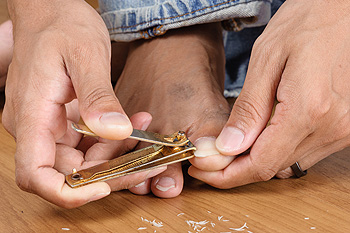 The time one takes to care for the feet daily is possibly connected to preventing specific foot conditions from developing. It is beneficial to wear shoes that fit correctly, and they must provide adequate room for the toes to move freely in. This may be helpful in preventing bunions and hammertoes. Flip flops and high heels may be desirable to wear, but research has shown they may be harmful to the feet. Ingrown toenails may be avoided by frequently trimming the toenails straight across the toe. When the feet are washed and dried daily, the uncomfortable condition that is known as athlete’s foot may be avoided. Additionally, the feet will feel good when a moisturizer is applied, and this may be helpful in preventing cracked heels. Consulting with a podiatrist can be beneficial in acquiring additional knowledge about how to properly take care of your feet.
The time one takes to care for the feet daily is possibly connected to preventing specific foot conditions from developing. It is beneficial to wear shoes that fit correctly, and they must provide adequate room for the toes to move freely in. This may be helpful in preventing bunions and hammertoes. Flip flops and high heels may be desirable to wear, but research has shown they may be harmful to the feet. Ingrown toenails may be avoided by frequently trimming the toenails straight across the toe. When the feet are washed and dried daily, the uncomfortable condition that is known as athlete’s foot may be avoided. Additionally, the feet will feel good when a moisturizer is applied, and this may be helpful in preventing cracked heels. Consulting with a podiatrist can be beneficial in acquiring additional knowledge about how to properly take care of your feet.
Everyday foot care is very important to prevent infection and other foot ailments. If you need your feet checked, contact one of our podiatrists from Summerlin Foot & Ankle. Our doctors can provide the care you need to keep you pain-free and on your feet.
Everyday Foot Care
Often, people take care of their bodies, face and hair more so than they do for their feet. But the feet are a very important aspect of our bodies, and one that we should pay more attention to. Without our feet, we would not be able to perform most daily tasks.
It is best to check your feet regularly to make sure there are no new bruises or cuts that you may not have noticed before. For dry feet, moisturizer can easily be a remedy and can be applied as often as necessary to the affected areas. Wearing shoes that fit well can also help you maintain good foot health, as well as making it easier to walk and do daily activities without the stress or pain of ill-fitting shoes, high heels, or even flip flops. Wearing clean socks with closed shoes is important to ensure that sweat and bacteria do not accumulate within the shoe. Clean socks help to prevent Athlete’s foot, fungi problems, bad odors, and can absorb sweat.
If you have any questions please feel free to contact our office located in Las Vegas, NV . We offer the newest diagnostic and treatment technologies for all your foot and ankle needs.
 Athlete’s foot is a common fungal infection. A majority of athlete’s foot cases are caused by fungi that thrive in closed, warm, and moist environments. The fungi feed on Keratin, which is a protein found in the hair, nails, and skin. Athlete’s foot is mildly contagious and can spread through direct contact with the infection and by skin particles left on towels, shoes, or floors. Walking barefoot can increase the chances of contracting athlete’s foot. The risk can also go up depending on your susceptibility. People who have impaired immune systems or diabetes are at greater risk for infection if they have an open cut or sore on their foot. If you have developed athlete’s foot or feel that you may be at risk, it is advised that you consult with a podiatrist.
Athlete’s foot is a common fungal infection. A majority of athlete’s foot cases are caused by fungi that thrive in closed, warm, and moist environments. The fungi feed on Keratin, which is a protein found in the hair, nails, and skin. Athlete’s foot is mildly contagious and can spread through direct contact with the infection and by skin particles left on towels, shoes, or floors. Walking barefoot can increase the chances of contracting athlete’s foot. The risk can also go up depending on your susceptibility. People who have impaired immune systems or diabetes are at greater risk for infection if they have an open cut or sore on their foot. If you have developed athlete’s foot or feel that you may be at risk, it is advised that you consult with a podiatrist.
Athlete’s foot is an inconvenient condition that can be easily reduced with the proper treatment. If you have any concerns about your feet and ankles, contact one of our podiatrists from Summerlin Foot & Ankle. Our doctors will treat your foot and ankle needs.
Athlete’s Foot: The Sole Story
Athlete's foot, also known as tinea pedis, can be an extremely contagious foot infection. It is commonly contracted in public changing areas and bathrooms, dormitory style living quarters, around locker rooms and public swimming pools, or anywhere your feet often come into contact with other people.
Solutions to Combat Athlete’s Foot
Athlete’s foot can cause many irritating symptoms such as dry and flaking skin, itching, and redness. Some more severe symptoms can include bleeding and cracked skin, intense itching and burning, and even pain when walking. In the worst cases, Athlete’s foot can cause blistering as well. Speak to your podiatrist for a better understanding of the different causes of Athlete’s foot, as well as help in determining which treatment options are best for you.
If you have any questions please feel free to contact our office located in Las Vegas, NV . We offer the newest diagnostic and treatment technologies for all your foot and ankle needs.
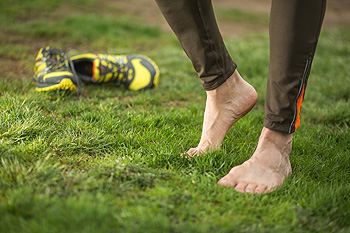 Research has shown it is beneficial for runners to develop habits that may help to prevent running injuries. Warming up before a run can improve range of motion and improve flexibility. Many runners find it helpful to begin their run with a purpose. This may include focusing on speed one day, and endurance the next day, in addition to deciding on what type of road to run on. Implementing breathing techniques may help to reduce any stiffness and tension that has developed during the run. It is important to stretch the body daily before a running practice begins, as this can help the hips, ankles and knees to remain flexible. If you would like additional information about how to prevent running injuries, it is suggested to counsel with a podiatrist, who can provide you with the correct techniques.
Research has shown it is beneficial for runners to develop habits that may help to prevent running injuries. Warming up before a run can improve range of motion and improve flexibility. Many runners find it helpful to begin their run with a purpose. This may include focusing on speed one day, and endurance the next day, in addition to deciding on what type of road to run on. Implementing breathing techniques may help to reduce any stiffness and tension that has developed during the run. It is important to stretch the body daily before a running practice begins, as this can help the hips, ankles and knees to remain flexible. If you would like additional information about how to prevent running injuries, it is suggested to counsel with a podiatrist, who can provide you with the correct techniques.
Exercising your feet regularly with the proper foot wear is a great way to prevent injuries. If you have any concerns about your feet, contact one of our podiatrists of Summerlin Foot & Ankle. Our doctors will treat your foot and ankle needs.
How to Prevent Running Injuries
Many common running injuries are caused by overuse and overtraining. When the back of the kneecap starts wearing out and starts causing pain in your knee, this is commonly referred to as runner’s knee. Runner’s knee is a decrease in strength in your quadriceps and can occur if you’re not wearing properly fitted or supporting shoes. To prevent runner’s knee, focusing on hip strengthening is a good idea, as well as strengthening your quads to keep the kneecaps aligned.
What Are Some Causes of Running Injuries?
- One cause of a common running injury is called iliotibial band syndrome.
- Plantar fasciitis is also another common injury.
- Stress fractures can occur from overtraining, lack of calcium, or even your running style.
Best Ways to Prevent Running Injuries
- Wear footwear that fits properly and suits your running needs.
- Running shoes are the only protective gear that runners have to safeguard them from injury.
- Make a training schedule. Adding strengthening exercises as well as regular stretching can help keep you strong and limber and can lessen the possibility of injuries.
- Stretching keeps muscles limber; this will help you gain better flexibility.
If you have any questions please feel free to contact our office located in Las Vegas, NV . We offer the newest diagnostic and treatment technologies for all your foot and ankle needs.
Rheumatoid arthritis is a chronic infla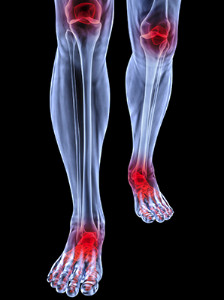 mmatory disorder that mainly affects the joints, but also can cause damage to other body systems. This form of arthritis occurs when the immune system mistakenly attacks the body’s own tissues. It affects the lining of the joints and causes painful swelling that can result in bone erosion and joint deformity in the ankles and feet. It can eventually cause the joint to stretch out, lose its shape and weaken all together. Some symptoms of rheumatoid arthritis include tender and swollen joints, joint stiffness, fever, fatigue and a loss of appetite. You are most at risk of getting the disease if you are a smoker, overweight and aged 55 or younger, as well as if you have had recent exposure to asbestos or silica. If you believe you may have developed rheumatoid arthritis or are experiencing any of the symptoms, it is advised you see a podiatrist.
mmatory disorder that mainly affects the joints, but also can cause damage to other body systems. This form of arthritis occurs when the immune system mistakenly attacks the body’s own tissues. It affects the lining of the joints and causes painful swelling that can result in bone erosion and joint deformity in the ankles and feet. It can eventually cause the joint to stretch out, lose its shape and weaken all together. Some symptoms of rheumatoid arthritis include tender and swollen joints, joint stiffness, fever, fatigue and a loss of appetite. You are most at risk of getting the disease if you are a smoker, overweight and aged 55 or younger, as well as if you have had recent exposure to asbestos or silica. If you believe you may have developed rheumatoid arthritis or are experiencing any of the symptoms, it is advised you see a podiatrist.
Because RA affects more than just your joints, including the joints in your feet and ankles, it is important to seek early diagnosis from your podiatrist if you feel like the pain in your feet might be caused by RA. For more information, contact one of our podiatrists of Summerlin Foot & Ankle. Our doctors will assist you with all of your podiatric concerns.
What Is Rheumatoid Arthritis?
Rheumatoid Arthritis (RA) is an autoimmune disorder in which the body’s own immune system attacks the membranes surrounding the joints. Inflammation of the lining and eventually the destruction of the joint’s cartilage and bone occur, causing severe pain and immobility.
Rheumatoid Arthritis of the Feet
Although RA usually attacks multiple bones and joints throughout the entire body, almost 90 percent of cases result in pain in the foot or ankle area.
Symptoms
Diagnosis
Quick diagnosis of RA in the feet is important so that the podiatrist can treat the area effectively. Your doctor will ask you about your medical history, occupation, and lifestyle to determine the origin of the condition. Rheumatoid Factor tests help to determine if someone is affected by the disease.
If you have any questions please feel free to contact our office located in Las Vegas, NV . We offer the newest diagnostic and treatment technologies for all your foot and ankle needs.
Obesity is a common problem in American society. Approximately one third of the U.S. population is obese. Obesity is defined as a body mass index greater than 30. Obesity has the power to affect different aspects of the body, and one of the most common problems it causes is foot pain. There have been many studies that found a connection between an increased BMI and foot problems. A simple activity such as walking up a flight of stairs can increase pressure on the ankle by four to six times.
Being overweight causes the body to compensate for the extra weight by changing the way it moves. Consequently, people who struggle with obesity commonly have arch problems in their feet. Obesity causes the arch to break by stretching the ligaments and tendons that hold the bones in the foot together. When the arch lowers, the foot may eventually fall flat. Collapsed foot arches fail to provide adequate shock absorption which eventually leads to foot pain. Other conditions that may be caused by flat feet are pronation, plantar fasciitis, weak ankles, and shin splints.
Foot problems that are caused by obesity may be treated by wearing proper footwear. Proper shoes will allow your feet to have better circulation around the arch and ankle. Additionally, those with obesity often discover that typical heel pain remedies are not effective for them. They will find that their plantar fascia is easily injured, and it is often inflamed. The best way to treat this problem is to implement lifestyle changes. A few good ways to improve your diet are to reduce calories, fill up on fruits and veggies, and to limit sugars.
Custom foot orthotics can prevent foot problems if you’re carrying excess weight or are trying to lose weight. The purpose of orthotics is to provide shock absorption to decrease the amount of stress on the joints to prevent arthritis.
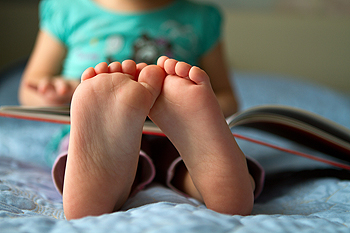 If your child complains of pain on the side of the big toe, it may be indicative of an ingrown toenail. Additional symptoms include swelling and redness in the corner of the affected toe, difficulty in walking, and possible drainage. This condition typically develops as a result of toenails that are trimmed incorrectly, or from wearing shoes that do not fit properly. Mild relief can be obtained from soaking the affected nail in warm water, which may help to soften the nail. If the symptoms become severe, it is advised to speak to a podiatrist as quickly as possible, so proper treatment can begin.
If your child complains of pain on the side of the big toe, it may be indicative of an ingrown toenail. Additional symptoms include swelling and redness in the corner of the affected toe, difficulty in walking, and possible drainage. This condition typically develops as a result of toenails that are trimmed incorrectly, or from wearing shoes that do not fit properly. Mild relief can be obtained from soaking the affected nail in warm water, which may help to soften the nail. If the symptoms become severe, it is advised to speak to a podiatrist as quickly as possible, so proper treatment can begin.
Ingrown toenails can become painful if they are not treated properly. For more information about ingrown toenails, contact one of our podiatrists of Summerlin Foot & Ankle. Our doctors can provide the care you need to keep you pain-free and on your feet.
Ingrown Toenails
Ingrown toenails occur when a toenail grows sideways into the bed of the nail, causing pain, swelling, and possibly infection.
Causes
Prevention
Because ingrown toenails are not something found outside of shoe-wearing cultures, going barefoot as often as possible will decrease the likeliness of developing ingrown toenails. Wearing proper fitting shoes and using proper cutting techniques will also help decrease your risk of developing ingrown toenails.
Treatment
Ingrown toenails are a very treatable foot condition. In minor cases, soaking the affected area in salt or antibacterial soaps will not only help with the ingrown nail itself, but also help prevent any infections from occurring. In more severe cases, surgery is an option. In either case, speaking to your podiatrist about this condition will help you get a better understanding of specific treatment options that are right for you.
If you have any questions please feel free to contact our office located in Las Vegas, NV . We offer the newest diagnostic and treatment technologies for all your foot and ankle needs.
 The condition known as flat feet occurs when the arch is absent from the foot. This may happen as a result of the aging process, which can cause the arches to drop, in addition to genetic factors. The symptoms that are associated with flat feet may include pain in the heel and other areas of the foot, numbness, or weakness. If your foot lies flat on the ground while standing, this is generally indicative of flat feet. Luckily, there may be measures that can be implemented to obtain relief. These may include performing stretches to help improve flexibility, wearing custom-made orthotics, or wearing shoes that provide adequate support. If you think you have flat feet, be sure to schedule a consultation with a podiatrist, so they can properly treat this condition.
The condition known as flat feet occurs when the arch is absent from the foot. This may happen as a result of the aging process, which can cause the arches to drop, in addition to genetic factors. The symptoms that are associated with flat feet may include pain in the heel and other areas of the foot, numbness, or weakness. If your foot lies flat on the ground while standing, this is generally indicative of flat feet. Luckily, there may be measures that can be implemented to obtain relief. These may include performing stretches to help improve flexibility, wearing custom-made orthotics, or wearing shoes that provide adequate support. If you think you have flat feet, be sure to schedule a consultation with a podiatrist, so they can properly treat this condition.
Flatfoot is a condition many people suffer from. If you have flat feet, contact one of our podiatrists from Summerlin Foot & Ankle. Our doctors will treat your foot and ankle needs.
What Are Flat Feet?
Flatfoot is a condition in which the arch of the foot is depressed and the sole of the foot is almost completely in contact with the ground. About 20-30% of the population generally has flat feet because their arches never formed during growth.
Conditions & Problems:
Having flat feet makes it difficult to run or walk because of the stress placed on the ankles.
Alignment – The general alignment of your legs can be disrupted, because the ankles move inward which can cause major discomfort.
Knees – If you have complications with your knees, flat feet can be a contributor to arthritis in that area.
Symptoms
Treatment
If you are experiencing pain and stress on the foot you may weaken the posterior tibial tendon, which runs around the inside of the ankle.
If you have any questions please feel free to contact our office located in Las Vegas, NV . We offer the newest diagnostic and treatment technologies for all your foot and ankle needs.
Read more about What is Flexible Flat Foot?Flatfoot is classified as having the entire sole of the foot in contact or near contact to the ground while standing. The disorder is also known as fallen arches, because those affected have no arch in their feet. Flexible flatfoot and rigid flatfoot are the two types of flatfoot.
A person has flexible flatfoot if when sitting or standing on their toes, they have an arch that disappears when they stand with the entire foot on the ground. Flexible flatfoot may also be called “pediatric flatfoot” because the condition first appears in childhood. It is common among infants because the arch does not develop until the age of 5 or 6 years. Rigid flatfoot is not as common in children as it is with adults. This type of flatfoot is developed due to the weakening of tibialis posterior muscle tendon, a major supporting structure of the foot arch. Development of this deformity is progressive and shows early signs of pain and swelling that begins at the inside arch of the foot and moves to the outside of the foot below the ankle. More severe cases can possibly lead to arthritis of the foot and ankle joints.
Although most cases of flatfoot involve people born with the condition, some less common causes are obesity, diabetes, pregnancy, and osteoporosis. In some cases, flatfoot may come with no symptoms at all and does not require any type of treatment. With other cases though, symptoms may include pain in the shin, knee, hips and lower back. If a person with flatfeet experiences such symptoms, a health care provider may suggest using orthotic devices or arch supports, which may reduce the pain. Wearing supportive shoes can also prove more comfortable with flatfeet and staying away from shoes with little support such as sandals. Other methods to relieve pain also include stretching the Achilles tendon properly and using proper form when doing any physical activity. In addition, losing weight can reduce the stress on your feet and reduce the pain.
 The tendon that connects the heel bone to the calf muscles is referred to as the Achilles tendon. This tendon is responsible for helping the feet push off the ground while walking, running, or jumping. It may become torn as a result of an injury that has happened to it. Many things can cause this to occur, including running uphill, participating in sporting activities that involve sharp turns, or possibly from falling. Some of the symptoms that are associated with this type of injury may include feeling pain and discomfort in the back of your ankle, having difficulty while standing on your tiptoes, or your leg may appear swollen. Mild relief may be found when the affected leg is elevated, and this may be helpful in reducing the swelling. If you have torn your Achilles tendon, it is suggested that you consult with a podiatrist who can offer proper treatment options.
The tendon that connects the heel bone to the calf muscles is referred to as the Achilles tendon. This tendon is responsible for helping the feet push off the ground while walking, running, or jumping. It may become torn as a result of an injury that has happened to it. Many things can cause this to occur, including running uphill, participating in sporting activities that involve sharp turns, or possibly from falling. Some of the symptoms that are associated with this type of injury may include feeling pain and discomfort in the back of your ankle, having difficulty while standing on your tiptoes, or your leg may appear swollen. Mild relief may be found when the affected leg is elevated, and this may be helpful in reducing the swelling. If you have torn your Achilles tendon, it is suggested that you consult with a podiatrist who can offer proper treatment options.
Achilles tendon injuries need immediate attention to avoid future complications. If you have any concerns, contact one of our podiatrists of Summerlin Foot & Ankle. Our doctors can provide the care you need to keep you pain-free and on your feet.
What Is the Achilles Tendon?
The Achilles tendon is a tendon that connects the lower leg muscles and calf to the heel of the foot. It is the strongest tendon in the human body and is essential for making movement possible. Because this tendon is such an integral part of the body, any injuries to it can create immense difficulties and should immediately be presented to a doctor.
What Are the Symptoms of an Achilles Tendon Injury?
There are various types of injuries that can affect the Achilles tendon. The two most common injuries are Achilles tendinitis and ruptures of the tendon.
Achilles Tendinitis Symptoms
Rupture Symptoms
Treatment and Prevention
Achilles tendon injuries are diagnosed by a thorough physical evaluation, which can include an MRI. Treatment involves rest, physical therapy, and in some cases, surgery. However, various preventative measures can be taken to avoid these injuries, such as:
If you have any questions please feel free to contact our office located in Las Vegas, NV . We offer the newest diagnostic tools and technology to treat your foot and ankle needs.
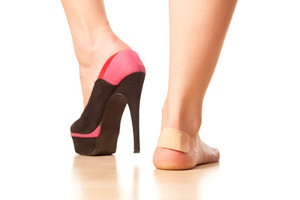 Many women who enjoy wearing high heels may be unaware of the possible harm these types of shoes may do to the feet. When high heels are worn, the weight of the body may get shifted to the joint under the big toe. This may result in the formation of a bunion, which is characterized by a bony protrusion on the side of the big toe. Corns and calluses may form on the bottom of the foot and may result in metatarsalgia. This type of pain is typically felt in the ball of the foot. If you have pain in your heel and surrounding areas, it may lead to a condition that is referred to as plantar fasciitis. It may be similar to the pain and discomfort that is experienced with heel spurs, and both conditions may develop as a result of frequently wearing high heels. If you have any of these symptoms, please consult with a podiatrist who can guide you toward proper treatment.
Many women who enjoy wearing high heels may be unaware of the possible harm these types of shoes may do to the feet. When high heels are worn, the weight of the body may get shifted to the joint under the big toe. This may result in the formation of a bunion, which is characterized by a bony protrusion on the side of the big toe. Corns and calluses may form on the bottom of the foot and may result in metatarsalgia. This type of pain is typically felt in the ball of the foot. If you have pain in your heel and surrounding areas, it may lead to a condition that is referred to as plantar fasciitis. It may be similar to the pain and discomfort that is experienced with heel spurs, and both conditions may develop as a result of frequently wearing high heels. If you have any of these symptoms, please consult with a podiatrist who can guide you toward proper treatment.
High heels have a history of causing foot and ankle problems. If you have any concerns about your feet or ankles, contact one of our podiatrists from Summerlin Foot & Ankle. Our doctors can provide the care you need to keep you pain-free and on your feet.
Effects of High Heels on the Feet
High heels are popular shoes among women because of their many styles and societal appeal. Despite this, high heels can still cause many health problems if worn too frequently.
Which Parts of My Body Will Be Affected by High Heels?
What Kinds of Foot Problems Can Develop from Wearing High Heels?
How Can I Still Wear High Heels and Maintain Foot Health?
If you want to wear high heeled shoes, make sure that you are not wearing them every day, as this will help prevent long term physical problems. Try wearing thicker heels as opposed to stilettos to distribute weight more evenly across the feet. Always make sure you are wearing the proper shoes for the right occasion, such as sneakers for exercising. If you walk to work, try carrying your heels with you and changing into them once you arrive at work. Adding inserts to your heels can help cushion your feet and absorb shock. Full foot inserts or metatarsal pads are available.
If you have any questions please feel free to contact our office located in Las Vegas, NV . We offer the newest diagnostic and treatment technologies for all your foot and ankle needs.